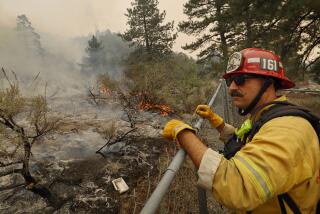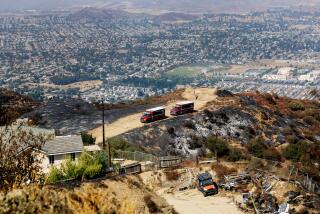1,155 homes -- and counting

Exhausted and sometimes discouraged, firefighters struggled for a third day Tuesday to wrest control of more than a dozen wildfires in Southern California that threatened such familiar landmarks as the Mt. Palomar Observatory and the resort communities around Lake Arrowhead.
Fire crews threw everything they had at the fires, but though there were notable successes, the toll of acreage, homes and lives lost continued to rise -- as did the volume of criticism from those who said the region was woefully unprepared for the cataclysm.
By late Tuesday, the blazes had burned 420,424 acres -- about 656 square miles -- and destroyed 1,155 homes, making them nearly as large as the fires in October 2003 that are considered the biggest in California history. Although only one death has been directly attributed to the fires, five others have been linked to them.
“If we had more air resources, we would have been able to control this fire,” said a frustrated Orange County Fire Authority Chief Chip Prather. “Instead we’ve been stuck in this initial attack mode on the ground where we hopscotch through neighborhoods as best we can trying to control things.”
Prather spoke at a news briefing Tuesday morning less than a mile from what had been an idyllic residential enclave at Modjeska Canyon, near El Toro in eastern Orange County. As he spoke, the canyon was erupting in an inferno that forced firefighters to retreat and destroyed an undetermined number of homes.
Mark Jackson, who had lived in the canyon for 25 years, lost his house when winds shifted and flames jumped across a road.
“When I left it was fully engulfed and there wasn’t a fireman in sight,” Jackson said.
Another hot spot was Lake Arrowhead and surrounding resort communities, where fire had consumed about 300 homes and was threatening 10,000 more, according to state forestry officials. All of Lake Arrowhead and several surrounding communities were under mandatory evacuation orders late Tuesday.
The fire roared through the mountain community of Fredalba, which by late Tuesday afternoon was an eerie vision of white ash and burning stumps on a carpet of blackened pine needles. Severed power lines dangled along Fredalba Road, and virtually nothing was left of the homes that had surrounded the town’s historical marker, which noted that it had been the home of Brookings Lumber Co. between 1898 and 1911.
Amid the devastation were small reminders of what had existed a day earlier: A charred sports car with flames burning where the headlights once were. A bent and twisted basketball hoop. A ghostly metal table with four chairs still in place around it.
In a story that was repeated in many places throughout the region, there simply were not enough firetrucks to chase down the fire that swept from Running Springs into the steep, winding roads of Fredalba on Tuesday morning, said Brian Savage, a division supervisor with the Culver City Fire Department who was among the first to begin battling back the flames.
He added that the clutter left by homeowners around their wooded yards increased the fire’s pace.
“You tell people to do clearance and they think it’s OK to leave the woodpiles and the sheds. That stuff starts burning and it’s right up next to the house,” Savage said. “They just don’t get it. We can’t be at every house. . . . It’s frustrating.”
Amid the gloom that hung over the region in the form of both smoke and shadowed emotions, there was good news from weather forecasters, who said that the Santa Ana winds had begun to ease and that significant relief should come Friday, when more typical onshore breezes begin to blow in from the Pacific.
“It will be a lot cooler, a lot more humid, and that will really slow down these fires,” said Bill Patzert, a climatologist for the Jet Propulsion Laboratory in La Cañada-Flintridge.
That news prompted Ron Lake, director of the San Diego County Office of Emergency Services, to declare: “The worst is behind us.”
The White House, eager not to repeat its experience in Hurricane Katrina, announced that President Bush would travel to Southern California on Thursday to tour damaged areas and monitor the federal government’s response. Homeland Security Secretary Michael Chertoff and R. David Paulison, director of the Federal Emergency Management Agency, arrived in California on Tuesday.
“The world is watching how much of . . . the southern part of the state is on fire,” said White House press secretary Dana Perino. “The federal government is very concerned, [and] the president is concerned himself.
“There were lessons learned out of Katrina,” she said, “and I think we are applying some of those, especially when it comes to early communication between our staff here at the federal level and then the governor’s staff.”
The Bush administration was harshly criticized for reacting too slowly to the threat from Hurricane Katrina and botching the jobs of evacuation and reconstruction once the storm had devastated New Orleans and other Gulf Coast communities.
The Insurance Information Network of California, an insurance industry trade association, estimated that covered property losses from the fires would be at least $500 million, a figure likely to change as the fires progress and more is learned about the damage.
The death toll remained uncertain, given the circumstances under which some people died. One man, whose name was not made public, died Tuesday of injuries suffered in an auto accident that occurred as he was fleeing the Buckweed fire near Santa Clarita. Four San Diego County evacuees died, two as they were being moved from medical facilities, a county medical examiner official said. The other two were a 62-year-old evacuee who fell and hit her head while leaving a restaurant, and a 95-year-old who was found dead in her hotel room in Old Town San Diego.
Evacuation orders were issued for about 350,000 households in San Diego County alone, though some have been rescinded.
Some victims wound up at UC San Diego Medical Center’s burn unit. Of 17 fire-related patients there, five were firefighters, four of whom had been caught while battling the Harris fire in the border area of south San Diego County, said Dr. Raul Coimbra, the hospital’s chief of trauma, surgical critical care and burns. The unit is the only regional burn center in the county.
Two of the firefighters were in critical condition, three others fair to good. A sixth firefighter was discharged Tuesday.
Among the other patients at the burn center were “a number of people that we call ‘border crossers,’ ” Coimbra said. They were caught in the fire in the area north of Tecate, Mexico.
Firefighters continued to express a mixture of awe and frustration at the scope of the fire.
In the devastated Poway community of High Valley, fire engineer Eric Wilson of the Vacaville Fire Department was puffing on a cigar during a break. His face was smudged with the soot from a fire that had vanquished up to 60 homes. Wilson has fought fires for 17 years, but never, he said, had he seen winds like this.
“There was nothing you could do,” Wilson said. “It was just flames, man. The wind was blowing flames from house to house.”
The strike team had used bump-and-run techniques. If a house began to burn, they moved on to the next one -- the one that still could be saved.
“You just have to accept the fact that you can’t save it all,” Wilson said wearily. “We were fighting the wind. I ain’t never seen anything like that.”
Just then, the radio crackled. The firefighters jumped to their feet. They were off to another front.
The San Diego County Sheriff’s Department reported several arrests for looting, including two in Ramona, near the origin of the Witch fire.
Along the multi-pronged front, which reached from Ventura to San Diego counties, firefighters made progress in some areas, including Malibu and the Santa Clarita area, and suffered setbacks in others.
Marines were evacuated from a portion of Camp Pendleton when two fires broke out on the huge military base. One of the blazes, the Ammo fire, raised concern because it was at the base of San Onofre Peak and was climbing toward an array of telecommunications equipment at the top. The San Onofre nuclear power plant is on the other side, prompting a request from Gov. Arnold Schwarzenegger to bring in air tankers to douse the flames.
Farther inland, officials said, a fire on Mt. Palomar had exploded to 20,000 acres and could threaten the famed observatory at the top, one of the world’s largest telescopes.
Along the foot of the south grade of Palomar Mountain, where fire crews worked with diggers and other heavy equipment to establish a break line, a ranching family corralled about two dozen retired thoroughbred horses into trailers as flames bore down on their property.
“How many you got there?” Cathy Simm yelled to a fellow rancher, Ivan Schwalm, as he helped load some of the horses. The ranchers held or tied dishrags and bandannas over their faces and shouted over the roar of the firestorm. Danger seemed moments away.
“Mom, move away from the power lines. They may come down,” Simm screamed.
Betty Simm made it out of harm’s way. The horses made it to safety as well, but not before Betty Simm, 85, watched the flames catch up to her ranch. “There goes my house,” she said.
It was, she said, the second house she had lost to fire. The first was in the 1961 Bel-Air fire.
“You know, it’s just stuff,” she said.
“What can you do? God probably has something else for us to do.”
mitchell.landsberg@
latimes.com
More to Read
Sign up for Essential California
The most important California stories and recommendations in your inbox every morning.
You may occasionally receive promotional content from the Los Angeles Times.










